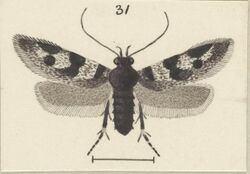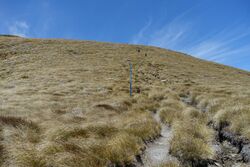Biology:Hierodoris insignis
| Hierodoris insignis | |
|---|---|

| |
| H. insignis illustrated by George Hudson | |
| Scientific classification | |
| Domain: | Eukaryota |
| Kingdom: | Animalia |
| Phylum: | Arthropoda |
| Class: | Insecta |
| Order: | Lepidoptera |
| Family: | Oecophoridae |
| Genus: | [[Biology:|Hierodoris]] |
| Species: | H. insignis
|
| Binomial name | |
| Hierodoris insignis Philpott, 1926[1]
| |
Hierodoris insignis is a species of moth in the family Gelechiidae.[1][2] It is endemic to New Zealand and has been found in the Nelson/Tasman districts. The larvae are leaf miners and are hosted by Celmisia species. Adults are on the wing in January. It is likely that this species belongs to another genus and as such this species is also known as Hierodoris (s.l.) insignis or 'Hierodoris' insignis.
Taxonomy
This species was first described by Alfred Philpott in 1926 under the name Hierodoris ? insignis.[3] He placed the species within the genus Hierodoris provisionally but stated that further material was needed to fix the genus with certainty.[3] In 1988 J. S. Dugdale placed this species within the family Gelechiidae.[1] In 2005 Robert Hoare commented that H. insignis is completely unrelated to the genus it is currently placed in, that is Hierodoris.[2] As a result of this disputed placement this species is also known as Hierodoris (s.l.) insignis or 'Hierodoris' insignis.[2][4] The male holotype specimen, collected by S. Lindsay at an altitude of 4000 ft on the Mount Arthur tableland, is held in the Canterbury Museum.[1]
Description
Philpott described this species as follows:
♀. 12 mm. Head and thorax dark bronzy-purplish-fuscous. Palpi and antennae dark brownish-fuscous. Abdomen dark purplish-brown. Legs dark fuscous, tibiae and tarsi obscurely annulated with greyish-white. Forewings moderate, costa slightly arched, apex rounded, termen extremely oblique; white, densely irrorated with leaden-grey; along dorsum wholly leaden-grey; markings purplish-black; a nearly straight, broad, subbasal fascia, an outwardly-oblique, broad, irregular fascia from costa at ⅓, reaching to fold; a large round spot in disc at ⅔, almost touching a semi-oval spot on costa; a fuscous suffusion along termen: fringes fuscous-grey with some white scales. Hindwings under 1, trapezoidal; purplish-fuscous: fringes fuscous.[3]
Distribution
This species is endemic to New Zealand and is found in the Nelson/Tasman districts.[3][5]
Behaviour
The adults of this species are on the wing in January.[6]
Habitat and hosts
The larvae of this species is a leaf miner.[1] It mines the tomentum underneath the leaves of Celmisia species.[1]
References
- ↑ 1.0 1.1 1.2 1.3 1.4 1.5 , pp. 81, Wikidata Q45083134
- ↑ 2.0 2.1 2.2 , Wikidata Q44994400
- ↑ 3.0 3.1 3.2 3.3 , pp. 397, Wikidata Q63100760
- ↑ , pp. 459, Wikidata Q45922947
- ↑ "Hierodoris insignis Philpott, 1926". https://www.nzor.org.nz/names/b9ca58f5-39cd-4fac-ae8a-edc83cb1e833.
- ↑ , pp. 306, Wikidata Q58593286
Wikidata ☰ Q13231070 entry
 |


